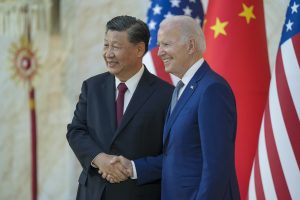China-U.S. relations have deteriorated to the point of “instability,” a dangerous new low for the world’s two biggest economies and militaries.
If queried on the source of instability, the two sides would give very different accounts.
U.S. officials would point to unsafe Chinese military interactions with U.S. vessels, and China’s refusal of meetings between defense ministers as destabilizing. Beijing’s plans to coercively reunify with Taiwan and the need for the U.S. to deter such action would also be raised. Many would cite examples of China’s disregard for the “rules-based international order,” including human rights and trade violations and its bullying of its neighbors. Others might blame China’s ambition to replace the United States as the hegemonic power in Asia.
Chinese officials would point to Washington’s adoption of “major power competition” in 2017 and the follow-on series of punitive U.S. policy actions as the main destabilizing factor. They would cite the U.S. launch of a “trade war” and imposition of tariffs, blacklists, and sanctions, as well as attempts to thwart China’s technological modernization plans by blocking its imports of high-end computer chips. They would view increased U.S. support for Taiwan, including then-House Speaker Nancy Pelosi’s August 2022 visit and an escalation of military support, as destabilizing. And they perceive U.S. construction of an Asian security order that “excludes and targets China.”
Neither side believes their own actions cause instability. Yet, it is apparent to outsiders that both sides are contributing. As Singapore Foreign Minister Vivian Balakrishnan explained, “[E]ach side’s anxiety about being less vulnerable creates a self-fulfilling prophecy where you try to be self-sufficient, you try to create parallel or even rival systems.”
As relations became increasingly tense following the balloon incident in February 2023, U.S. President Joe Biden indicated he anticipated a “thaw” in China-U.S. relations. The two sides then moved to line up a series of high-level official meetings in accordance with earlier discussions. Chinese officials welcomed these meetings in the hope that they could help produce stability and improve relations, as President Xi Jinping told Secretary of State Antony Blinken during his recent visit.
Beijing and Washington have different ideas, however, about what “stabilizing ties” entails.
Biden administration officials describe their goal as “demonstrating that the two can responsibly manage their major power competition,” or as one headline put it, to show that the two can “fight nicely.”
Chinese officials reject the notion of major power competition and insist that the deterioration in China-U.S. relations stems from a U.S. strategic misperception of China: variously, that China seeks to “replace the U.S.,” to “rewrite the global rules,” or to “export its model of autocracy.” Chinese officials reject these assessments and want to see a “thaw” that would put China-U.S. relations “back on track” and see the United States “adopt a rational and pragmatic attitude.”
While “thaw,” “fighting nicely,” and “pragmatic attitude” may not sound mutually exclusive, these are two different visions and they will be difficult to reconcile.
For the Biden vision to prevail, Chinese officials must acknowledge and accept what many in the U.S. now consider a given: that China is the primary adversary of the United States. Chinese officials will decline to do so, claiming a need to focus resources on China’s own development rather than on competition with the United States. But it is precisely China’s military and technological development that the U.S. views as a direct challenge.
For the Chinese preference to emerge, the U.S. would have to judge the benefits of improved relations as potentially outweighing the security vulnerabilities inspired by China’s development. That will be hard to sell in light of recent history and in the current U.S. political environment.
The best outcome, therefore, is likely one that takes advantage of the impulse to stabilize relations by continuing high-profile diplomatic engagement. While such engagement may not produce marked improvements, it can reduce risk, dispel immediate anxieties, and provide more predictability and confidence for our collective future.
In a series of articles, Chinese and American experts intend to make explicit the misperceptions that drive the mistrust in the ever-increasing instability in the bilateral relationship. Find the whole series here.
































